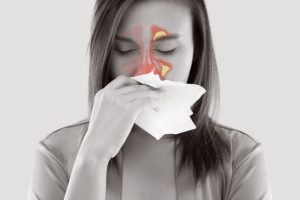Rhinitis VS Sinusitis
Rhinitis vs sinusitis are two common medical conditions that primarily affect the respiratory system. Rhinitis, often referred to as “hay fever” or “allergic rhinitis,” is an inflammation of the nasal passages. It is typically caused by allergens such as pollen, dust mites, or pet dander and results in symptoms like sneezing, runny or stuffy nose, and itching. Rhinitis is usually not associated with a bacterial or viral infection and is more often related to allergies.
Rhinitis vs. Sinusitis: What’s the Difference?

When it comes to nasal discomfort and congestion, two common conditions often cause confusion: rhinitis and sinusitis. While their symptoms may overlap, they have distinct differences in their causes and treatments. In this article, we’ll unravel the mystery behind rhinitis and sinusitis, helping you understand their disparities and how to manage them effectively.Read about: 7 Warning Signs of Dengue Fever
Understanding Rhinitis
What is Rhinitis?
Rhinitis is a condition characterized by inflammation of the nasal lining, resulting in symptoms such as a runny or stuffy nose, sneezing, and itching. It’s typically triggered by allergens like pollen, dust mites, or pet dander.
Types of Rhinitis
Allergic Rhinitis: This form of rhinitis occurs when your immune system overreacts to allergens, leading to symptoms.
Non-Allergic Rhinitis: Unlike allergic rhinitis, this type is not triggered by allergens and can be caused by factors like changes in weather or irritants.
Symptoms of Rhinitis
Runny nose
Sneezing
Itchy or watery eyes
Nasal congestion
Understanding Sinusitis
What is Sinusitis?
Sinusitis is the inflammation of the sinuses, which are the hollow cavities around your nose and eyes. It can be caused by infections, allergies, or other factors. Sinusitis leads to symptoms like facial pain, pressure, and a feeling of fullness in the face.
Types of Sinusitis
Acute Sinusitis: This is a short-term infection that typically follows a cold. It can cause symptoms like facial pain, thick nasal discharge, and fever.
Chronic Sinusitis: Chronic sinusitis lasts longer, often for 12 weeks or more, and symptoms are similar to those of acute sinusitis.
Symptoms of Sinusitis
Facial pain and pressure
Nasal congestion
Thick nasal discharge
Cough
Fever
Can Rhinitis Lead to Sinusitis?
Rhinitis, a common condition characterized by inflammation and irritation of the nasal passages, can indeed lead to sinusitis under certain circumstances. Rhinitis itself is typically caused by allergens or viral infections and results in symptoms like a runny or stuffy nose, sneezing, and itching. If left untreated or if the underlying causes persist, rhinitis can contribute to the development of sinusitis. Sinusitis, on the other hand, is an inflammation of the sinuses, which are air-filled cavities surrounding the nasal passages. Prolonged rhinitis can lead to blockages in the nasal passages, preventing the sinuses from draining properly. Discover more: Can You Get Monkeypox More Than Once
This blockage creates an ideal environment for the growth of bacteria or viruses, leading to sinusitis. The symptoms of sinusitis often include facial pain, pressure, and congestion, along with possible fever and headache. Therefore, rhinitis vs sinusitis it’s important to manage rhinitis effectively, whether through allergen avoidance, antihistamines, or decongestants, to reduce the risk of it progressing into sinusitis.
Rhinitis vs. Sinusitis: The Key Differences

While rhinitis and sinusitis share some symptoms, they differ in several important ways:
Primary Location: Rhinitis primarily involves inflammation of the nasal passages, while sinusitis affects the sinuses around the nose and eyes.
Causes: Rhinitis is often triggered by allergens, while sinusitis can be caused by infections, allergies, or irritants.
Duration: Rhinitis can be persistent but usually resolves when the allergen is removed or treated. Sinusitis may be acute or chronic, with long-lasting symptoms.
Symptoms: Both conditions may cause nasal congestion, but sinusitis is more likely to lead to facial pain and thick nasal discharge.
Managing Rhinitis and Sinusitis
Rhinitis Management
Identify and avoid allergens.
Over-the-counter antihistamines can help manage symptoms.
Nasal corticosteroid sprays can reduce inflammation.
Allergy shots may be considered for severe cases.
Sinusitis Management
Acute sinusitis often resolves on its own, but you can use decongestants and pain relievers to alleviate symptoms.
Chronic sinusitis may require antibiotics, nasal corticosteroid sprays, or in some cases, surgery to improve sinus drainage.
Conclusion
In conclusion, while rhinitis vs sinusitis may cause similar nasal symptoms, they have distinct differences in their causes, locations, and treatments. Understanding these disparities is essential for effective management and relief. If you’re unsure about your condition or if symptoms persist, consult a healthcare professional for a proper diagnosis and guidance.
FAQs
Q. Can rhinitis lead to sinusitis?
Rhinitis can increase the risk of sinusitis, especially if it is left untreated and leads to persistent nasal congestion.
Q. What is the best way to differentiate between allergic rhinitis and sinusitis? Allergic rhinitis often involves itching and watery eyes, while sinusitis typically leads to facial pain and thick nasal discharge.
Q. Are there any home remedies for relieving sinusitis symptoms?
Steam inhalation, saline nasal rinses, and warm compresses over the sinuses can provide relief for sinusitis symptoms.
Q. How can I prevent allergic rhinitis symptoms when exposed to allergens?
You can reduce allergen exposure by keeping windows closed, using air purifiers, and taking allergy medications as recommended by your doctor.
Q. Is chronic sinusitis a common condition? Chronic sinusitis is not as common as acute sinusitis but can affect individuals who have recurring or long-lasting symptoms.










